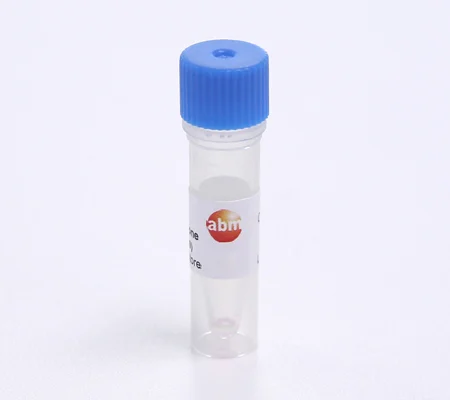
Ligation-Free Cloning Kit

| CAT.NO | UNIT |
|---|---|
| E001 | 25 Reactions |
| Description | The Ligation-Free Cloning kit is a versatile system to meet the demands of routine cloning projects. The progressive design has eliminated the requirement for compatible ends and unique restriction sites within the vector and inserts to be cloned. At the foundation of Ligation-Free Cloning technology is abm’s proprietary Ligation-Free Enzyme Mix which reliably facilitates the assembly of up to 3 DNA inserts (PCR-generated sequences) and a linearized vector by recognizing a 15 bp overlap region at both ends. This 15 bp overlap can be engineered by designing primers for amplification of your desired sequences to create inserts free from any redundant or unwanted base pairs. To eliminate the possibility of mutations associated with PCR amplification, scientists at abm have developed a DNA Polymerase with the highest proof-reading capability thus making this system the most reliable on the market. |
|---|---|
| SKU | E001 |
| Unit quantity | 25 Reactions |
| Applications |
|
What is the mechanism between the 15 bp of each fragment extremity, the linearisation of the vector and the insertion of the fragment into this vector?
The vector overlap sequence doesn't have to be exactly 15 bp in size. We see good results when the overlap sequence is between 15bp-30bp. However, the vector overlap sequence must immediately precede the 5' restriction site on the forward primer, and immediately follow the 3' restriction site on the reverse primer. For example, if the vector MCS sequence is the following and the sites to be used are XhoI and EcoRI (CTCGAG, GAATTC respectively): 5'GGGGGGGGGGGGGGCTCGAGAAAAAAAAAAAAAGAATTCGGGGGGGGGGG-3' The Forward and Reverse primers should be like this: Forward Primer: 5' GGGGGGGGGGGGGGCTCGAGgene_specific_sequence_for_PCR Reverse Primer: 5' CCCCCCCCCCCGAATTCgene_specific_sequence_for_PCR The most important step in the protocol is to ensure complete restriction digestion of the vector. Incomplete digestion will result in higher background of parental vector. We recommend doing an overnight digestion for the vector using High Fidelity restriction enzymes that do not exhibit star activity. Alternatively, digesting for a longer time (i.e. 2-3 hours) will also help with getting better linearization of the vector, if overnight digests cannot be done.
How should the primers be designed?
The instructions for designing the primers, including the location of the restriction sites, as well as the protocol, can be found in the product manual under the "documents" section on this webpage. The system essentially recognizes the two 15bp common end sequences (which has to be on the ends of both fragments, i.e. the linearized vector and the PCR product), and recombines them together. Assuming that they are doing PCR cloning, they would need to design the primers like this: Forward Primer: 5' - Vector overlap sequence, 5' restriction site to be used, 5' gene specific region for amplification of insert - 3' Reverse Primer: 5' - Vector overlap sequence, 3' restriction site to be used, 3' gene specific region for amplification of insert - 3' For more information, please refer to Fig. 2b of the manual.
Can the reaction mix be incubated at 50C instead of on ice?
It is not recommend to incubate at 50C because the enzymes do not work efficiently at such a high temperature.
- Cheng, D. J., Tian, Y. P., Geng, C., Guo, Y., Jia, M. A., & Li, X. D. "Development and application of a full-length infectious clone of potato virus Y isolate belonging to SYR-I strain" Virus Research 197827: (2019).
- Deng, H., Gao, R., Chen, J., Liao, X., & Cai, Y. "An efficient polyethylene glycol-mediated transformation system of lentiviral vector in Shiraia bambusicola" Process Biochemistry 51(10):1357-1362 (2016).
- Deng, H., Gao, R., Liao, X., & Cai, Y. "Characterization of a major facilitator superfamily transporter in Shiraia bambusicola" Research in microbiology 168(7):664-672 (2017).
- Huang, B., Tang, X., Zhang, L., Li, L., Wang, W., Liu, M., & Zhang, G. "IKKε-like plays an important role in the innate immune signaling of the Pacific oyster (Crassostrea gigas)" Fish & shellfish immunology 93:551-558 (2019).
- Huang, B., Zhang, L., Xu, F., Tang, X., Li, L., Wang, W., … Zhang, G. "Oyster Versatile IKKα/βs Are Involved in Toll-Like Receptor and RIG-I-Like Receptor Signaling for Innate Immune Response" Frontiers in Immunology 10: (2019). DOI: 10.3389/fimmu.2019.01826.
- Liu, S., Li, L., Meng, J., Song, K., Huang, B., Wang, W., & Zhang, G. "Association and Functional Analyses Revealed That PPP1R3B Plays an Important Role in the Regulation of Glycogen Content in the Pacific Oyster Crassostrea gigas" Frontiers in Genetics 10: (2019). DOI: 10.3389/fgene.2019.00106.


